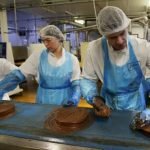
Consumer spending has boosted the economy, but rising inflation could slow that down this year CREDIT: JOHN STILLWELL/PA WIRE
Surging share prices are making households wealthier, boosting confidence and offsetting some of the squeeze from rising inflation and sluggish wage growth.
Britons’ net financial wealth has jumped by 12.5pc in the past year according to economists at the EY Item Club – rising four times more quickly than wages.
This “should provide some prop to spending this year” and so keep the economy growing, they hope.
However, this only benefits the relatively well off who own shares and other financial assets. As a result rising inflation will hit lower-paid households the hardest.




